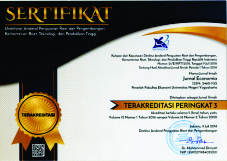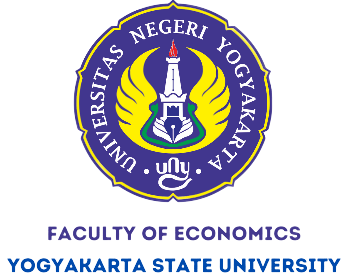The Role of E-Satisfaction in Influencing Online Repurchase Intention on Marketplace Sites in Indonesia
Downloads
Abstract
This study aims to see whether the e-satisfaction variable can have a mediating effect on e-service quality and perceived ease of use on online repurchase intention on marketplace sites. The consumers on the marketplace website were provided with online questionnaires as part of the research method. A total of 268 respondents were gathered. The data were then analyzed utilizing LISREL 8.70 software. The results revealed that e-satisfaction could partially mediate between e-service quality and online repurchase intention and could fully mediate between perceived ease of use on online repurchase intention. The implication is that marketplace sites need to improve e-satisfaction through e-service quality, which is continuously improved and provides easy-to-understand features for consumers; thus, it can encourage the desire to repurchase products/services on the marketplace site.
Keywords:E-Service Quality, Perceived Ease of Use, E-Satisfaction, Online Repurchase Intention, Marketplace
Downloads
Amin, M., Rezaei, S., & Abolghasemi, M. (2014). User satisfaction with mobile websites: the impact of perceived usefulness (PU), perceived ease of use (PEOU) and trust. Nankai Business Review International, 5(3), 258–274. http://dx.doi.org/10.1108/NBRI-01-2015-0001
Anderson, R. E., & Srinivasan, S. S. (2003). E-Satisfaction and E-Loyalty: A Contingency Framework. Psychology and Marketing, 20(2), 123–138. https://doi.org/10.1002/mar.10063
Baron, R. M., & A. Kenny, D. (1986). The Moderator-Mediator Variable Distinction in Social Psychological Research: Conceptual, Strategic, and Statistical Considerations. Journal of Personality and Social Psychology, 51(6), 1173–1182. https://doi.org/10.1007/BF02512353
Bitner, M. J., & Hubbert, A. R. (1994). Encounter Satisfaction vs Overall Satisfaction And Quality. In: Rust, R.T., Oliver, R.L. (Eds.), Service Quality: New Directions In Theory And Practice. Sage Publications.
Chen, Y. Y. (2012). Why Do Consumers Go Internet Shopping Again? Understanding the Antecedents of Repurchase Intention. Journal of Organizational Computing and Electronic Commerce, 22(1), 38–63. https://doi.org/10.1080/10919392.2012.642234
Chiu, C. M., Chang, C. C., Cheng, H. L., & Fang, Y. H. (2009). Determinants of customer repurchase intention in online shopping. Emerald Group Publishing Limited, 33(4), 761–784. https://doi.org/10.1108/14684520910985710
Ferdinand, A. (2006). Metode Penelitian Manajemen: Pedoman Penelitian untuk skripsi, Tesis dan Disertai Ilmu Manajemen. Universitas Diponegoro.
Hair, J., F., Anderson, R., E., Tatham, R., L., & Black, W., C. (2006). Multivariate Data Analysis (Edisi 6). Pearson Education.
Hair, J. F., Hult, G. T. M., Ringle, C., & Sarstedt, M. (2013). A primer on Partial Least Squares Structural Equation Modeling (PLS-SEM). Sage Publications.
harmony.co.id. (2020). Kelebihan dan Kekurangan Menjalankan Bisnis Online di Marketplace. Www.Harmony.Co.Id. https://www.harmony.co.id/blog/kelebihan-dan-kekurangan-menjalankan-bisnis-online-di-marketplace
Huang, P.-L., Lee, B. C. Y., & Chen, C.-C. (2019). The influence of service quality on customer satisfaction and loyalty in B2B technology service industry. Total Quality Management and Business Excellence, 30(13–14), 1449–1465. https://doi.org/10.1080/14783363.2017.1372184
Hussain, R., Al Nasser, A., & Hussain, Y. K. (2015). Service quality and customer satisfaction of a UAE-based airline: An empirical investigation. Journal of Air Transport Management, 42, 167–175. https://doi.org/10.1016/j.jairtraman.2014.10.001
Kemp, S. (2020). Digital 2020, Global Digital Overview, Essential Insight Into How People Around The World Use The Internet, Mobile Devices, Social Media, and E-Commerce. Www.Wearesocial.Com. https://wearesocial.com/digital-2020
Limayem, M., Hirt, S. G., & Cheung, C. M. K. (2007). How habit limits the predictive power of intention: The case of information systems continuance. MIS Quarterly: Management Information Systems, 31(4), 705–737. https://doi.org/10.2307/25148817
Lin, C. Y., Fang, K., & Tu, C. C. (2010). Predicting consumer repurchase intentions to shop online. Journal of Computers, 5(10), 1527–1533. https://doi.org/10.4304/jcp.5.10.1527-1533
Lu, L. C., Chang, H. H., & Yu, S. T. (2013). Online shoppers' perceptions of e-retailers' ethics, cultural orientation, and loyalty: An exploratory study in Taiwan. Emerald Group Publishing Limited, 23(1), 47–68. https://doi.org/10.1108/10662241311295773
Lukman, E. (2014). 5 Model Bisnis E-Commerce Di Indonesia [Online]. Www.Techinasia.Com. https://id.techinasia.com/5-model-bisnis-ecommerce-di-indonesia-2
Mensah, I., & Mensah, R. D. (2018). Effects of Service Quality and Customer Satisfaction on Repurchase Intention in Restaurants on University of Cape Coast Campus. Journal of Tourism, Heritage & Services Marketing, 4(1), 27–36. https://doi.org/10.5281/zenodo.1247542
Montazemi, A. R., & Saremi, H. Q. (2013). Factors affecting Internet banking pre-usage expectation formation. Proceedings of the Annual Hawaii International Conference on System Sciences, January, 4666–4675. https://doi.org/10.1109/HICSS.2013.231
Peyrot, M., & Doren, D. Van. (1994). Effect of a Class Action Suit on Consumer Repurchase Intentions. Journal of Consumer Affairs, 28(2), 361–379. https://doi.org/10.1111/j.1745-6606.1994.tb00857.x
Saleem, M. A., Zahra, S., & Yaseen, A. (2017). Asia Pacific Journal of Marketing and Logistics Impact of service quality and trust on repurchase intentions – the case of Pakistan airline industry Impact of service quality and trust on repurchase intentions – the case of Pakistan airline industry Sadaf. Asia Pacific Journal of Marketing and Logistics, 29(5), 1136–1159. https://doi.org/10.1108/APJML-10-2016-0192
Tandon, U., Kiran, R., & N.Sah, A. (2016). Analysing the complexities of website functionality, perceived ease of use and perceived usefulness on customer satisfaction of online shoppers in India. International Journal of Electronic Marketing and Retailing, 7(2), 115–140. https://doi.org/10.1504/IJEMR.2016.077118
Trivedi, S. K., & Yadav, M. (2018). Predicting online repurchase intentions with e-Satisfaction as mediator: a study on Gen Y. Emeraldinsight.
Turban, E., King, D., Lee, J., Liang, T.-P., & Turban, D. (2012). Electronic Commerce 2012 A Managerial and Social Networks Perspective. Pearson Education.
Varga, A., Dlacic, J., & Vujicic, M. (2014). Repurchase intentions in a retail store - exploring the impact of colours. Ekonomski Vjesnik, XXVII(2), 229–244.
Wen, C., R.Prybutok, V., & Xu, C. (2011). An Integrated Modal For University of North Texas. Journal of Computer Information Systems Accepted:, 52(1), 14–23.
Wijanto, S. H. (2008). Structural Equation Model dengan LISLER 8.8. Graha Ilmu.
Zeithaml, V. A., & Bitner, M. J. (2000). Service Marketing (Internatio). McGraw-Hill.















